Ruins of Azuchi Castle, a Special Historic Site Oda Nobunaga’s Stronghold for the Unification of JPN
1. History of Azuchi Castle
The construction of Azuchi Castle began in 1576, the year after Oda Nobunaga (1534–82) defeated Takeda Katsuyori at the Battle of Nagashino. Construction work was carried out by a huge number of laborers collected from the Kinai (roughly present-day Kansai), Tokai, and Hokuriku regions, as well as by mobilized artisans with then top-class skills. This fact suggests that Azuchi Castle was a crystallization of the essence of culture at that time, constructed to be foothold stronghold for national unification. The year 1579, three years after the start of construction, marked the completion of the castle as the residence of Nobunaga, in that the donjon (tenshu) was completed and he moved to the building. Another three years later, however, Akechi Mitsuhide killed Nobunaga in the Honnōji Incident in 1582, and acquired the castle. Then, soon after Mitsuhide was in turn defeated by Hashiba Hideyoshi, the donjon and Honmaru Bailey of Azuchi Castle were burnt down. Nevertheless, the castle continued to serve as a symbol of the Oda family’s reign, occupied and used by Nobukatsu, Nobunaga’s son, and Sanpōshi, Nobunaga’s grandson, to claim their status as heirs to Nobunaga. In 1585, Nobukatsu’s surrender to Hideyoshi after the Battle of Komaki and Nagakute brought an end to the Oda family’s reign and Azuchi Castle’s roles. Thus, Azuchi Castle became unoccupied. After that, Sōkenji Temple, a Buddhist temple built in the precincts of the castle by Nobunaga, has continued preserving the castle site until today, as well as praying for the repose of Nobunaga’s soul throughout the Edo Period.After the modern era began, the Azuchi Castle Site was designated as a historic site of Japan in 1926, and as a special historic site in 1952, and became a cultural property under the nation’s protection. Academic research and preliminary maintenance were performed concerning the donjon and Honmaru Bailey in 1940 and 1941, and more thorough maintenance work has been conducted since 1960, including repair of stone walls from the area near the Honmaru Bailey to the Kuroganemon Gate.To preserve Azuchi Castle toward the future and promote its wider use, a 20-year project to research and maintain the Azuchi Castle Site, a special historic site of Japan, was launched in fiscal 1989. Excavation was carried out at various sites in and around the castle, including the three roads connecting the castle to outside areas: the Otemichi road, Dodobashiguchimichi road, and Karametemichi road; baileys along the roads containing the supposed sites of the residences of Hashiba Hideyoshi, Maeda Toshiie, Takei Sekian, and Oda Nobutada, and the former site of Sōkenji Temple; the main bailey area containing the donjon and the Honmaru bailey and nearby areas; and the southern skirts of Mount Azuchi, containing Dodobashi Bridge, the supposed site of Otemon Gate, the site of inner moats, the area around the Hasuike Pond, and the Kitakoshigoe Pass.Additionally, facility maintenance work based on the research findings were done at the Otemichi road from the area around the supposed Otemon Gate site to the Kuroganemon Gate site, and the supposed sites of the residences of Hashiba, Maeda, Takei, and Oda Nobutada. Maintenance work at baileys and the restoration of stone walls and steps were also conducted. Thus, the project to research and maintain the Azuchi Castle Site was finished in 2008.
-
 map of Azuchi Castle (PDF:2 MB)
map of Azuchi Castle (PDF:2 MB)
2. Excavation at the ruin of Azuchi Castle Site, a special historic site
1) Research on the Otemichi road and the area around the Otemon Gate
The Otemichi road connects the main entrance and the castle. The existing road runs straight 180 m from the main entrance, leading to the area. Excavation showed that the road had branched into two routes: one from the supposed site of Nobutada’s residence to the Kuroganemon Gate, and the other leading to the south entrance of the supposed Sannomaru Bailey site. The road is about 8 m wide in its straight part, wider than any other road around the castle. The straight part of the road is bordered with stone-paved ditches and stone forts.
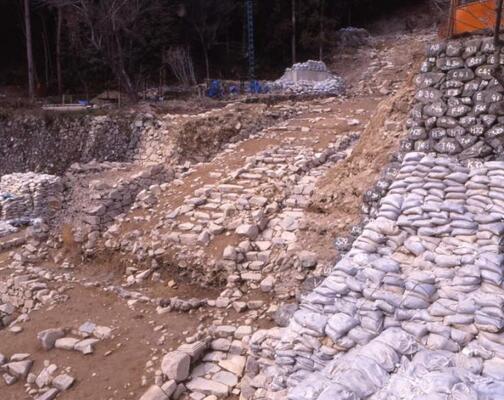
It is thought that the Otemon Gate was located about 80 m south from the foot of the existing stone steps. While the ancient foundations of the gate were destroyed, research on this area led to a surprising discovery; besides the supposed Otemon Gate site, three entrances were discovered: a simple entrance at the eastern end of a stone fort built east and west from the Otemon Gate, and a square-shaped entrance structure and a simple entrance at the western end of the fort. It is thought that the Otemon Gate and the two gates at both ends of the stone fort were built for ceremonies for imperial visits. Some researchers argue that this arrangement of gates was modeled after that of the Inner Palace in the Imperial Palace.
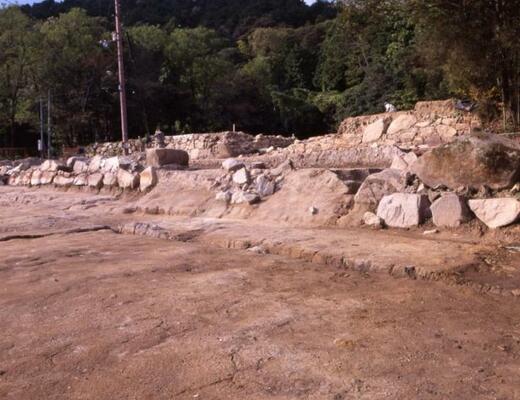
Moreover, although it was thought that the stone forts along the southern skirts of the main entrance area abutted an inner lake of Lake Biwa, research showed that dry land spread further south, with the same landscapes as today.
2) Research on residence sites —Supposed sites of the residences of Hashiba Hideyoshi and Maeda Toshiie—
The supposed sites of the Hashiba and Maeda residences are located across the straight part of the Otemichi road from each other. The supposed Hashiba residence site, on the west side of the road, has two vertical tiers of baileys connected by a 2-meter-wide passage (mushabashiri). The oldest turret gate used for a castle and a huge stable were discovered in the lower bailey, and the main palace as the main facility of the residence, a kitchen, and a corner turret for protecting the kitchen, in the upper bailey. It can be said that this is a rare case of a samurai residence site in which the arrangement of all buildings was clarified.
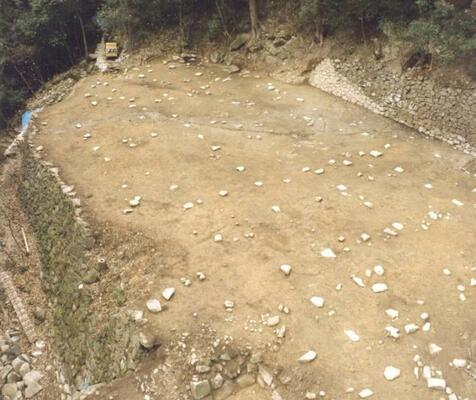
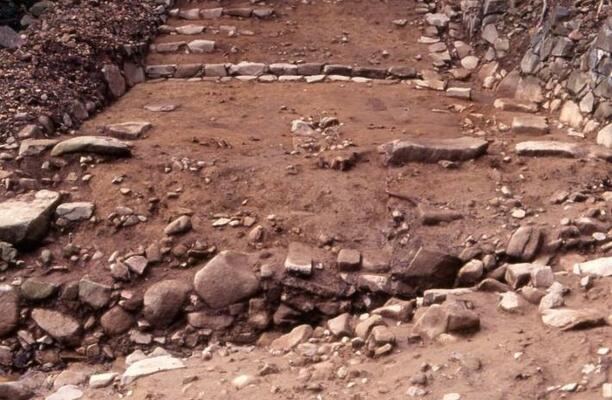
The supposed Maeda residence site, on the east side of the road, consists of three vertical tiers of baileys. At the entrance from the Otemichi road, there is a square-shaped structure within the wall, which leads to a stable and then to stone steps toward an inner drawing room. Two stone stairways in the frontage of the residence go up to the main palace, and a wider stone stairway in the south leads to the main building. A narrower stone stairway in the north goes under the Tamon-yagura Turret to a kitchen and an outer guardroom. At the site under the floor of the Tamon-yagura Turret, wooden gutters were discovered, and these are deemed to have been part of a drainage system for draining wastewater from a washing place.
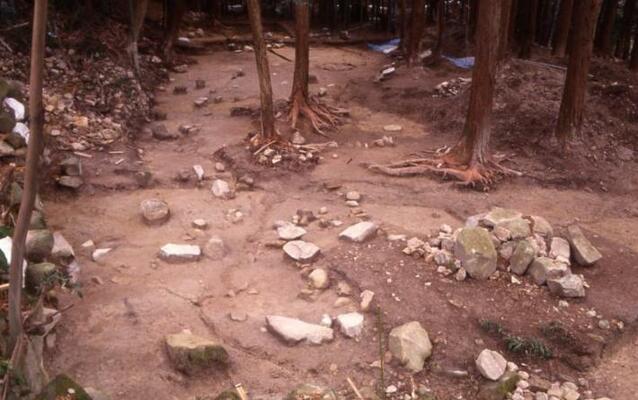
Many remains of daily life, including pieces of earthenware and ceramics, were excavated from the supposed sites of the Hashiba and Maeda residences, and these artifacts tell us about the lives of the people who lived there. Additionally, luxury items, including tea utensils and incense burners, were also unearthed, and they suggest that an elegant life unrelated to battles also existed in these residences.
3) Research on the main bailey area
The main bailey area containing the donjon and the Honmaru Bailey is the heart of the castle. A large number of gates and structures for hiding soldiers were found on the road along the perimeter of the main bailey area, and these confirm the castle’s high defense capacity based on meticulous planning. Multiple foundation stones were discovered near the north entrance of the main bailey area and the supposed site of a kitchen bailey next to it, and these stones seem to have been placed along common planned lines. Research revealed that there could have been, instead of a number of independent buildings, a large-scale building compound covering the entire area from the north entrance to the supposed site of a kitchen bailey. Furthermore, partly burnt pillar materials and still-standing remains of partly burnt wall parts on foundation stones were discovered in the area called “Ninomaru higashi-damari
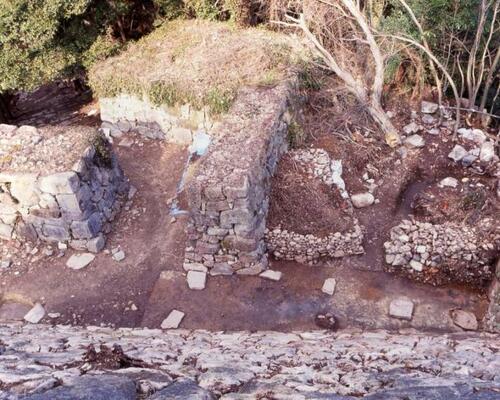
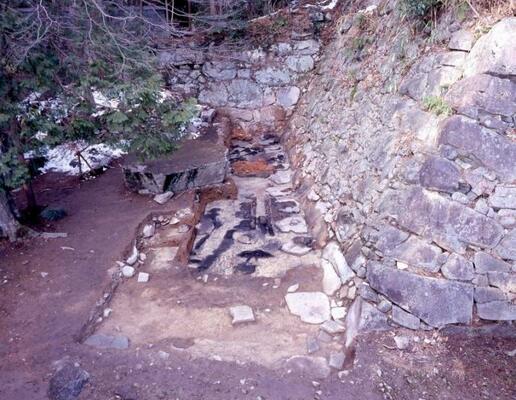
During the research on the supposed site of the Honmaru Bailey, all existing foundation stones were checked. As a result, it is thought that the building constructed on these foundation stones can have been built based on the same plan as Seiryoden, a building later constructed by Toyotomi Hideyoshi in the Inner Imperial Palace. Moreover, it is thought that this building deemed to have existed in the supposed Honmaru Bailey site corresponds to a building called “Miyuki no onmaShincho koki(a chronicle of Oda Nobunaga) mentions. This discovery raises an important question about the relationship between Nobunaga and the Emperor.
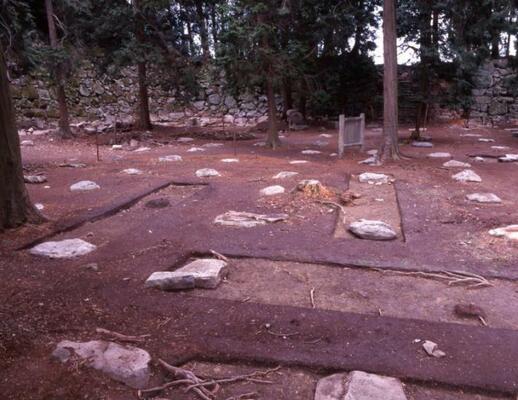
Research on the cellar under the donjon showed that plaster, which the pre-war research had found there, had not been used to construct the cellar. Furthermore, foundation stones and traces of removed foundation stones of side pillars accompanying main pillars were discovered at multiple points. As for the hole in the center of the cellar, which was our greatest concern, the previous research had identified traces of disturbance of the hole, and its functions were not yet elucidated. Geophysical exploration found that the base of the donjon was founded on a trimmed natural bedrock stratum. This is a valuable discovery that clarifies a more specific process of the construction of the donjon.
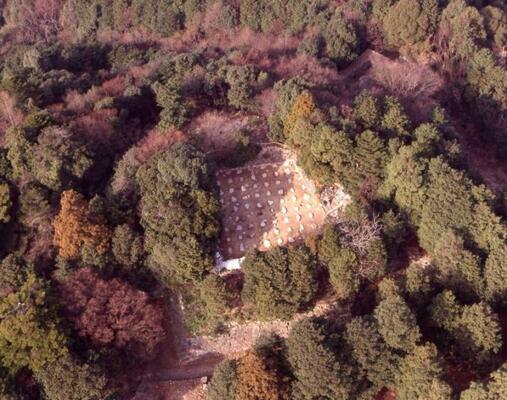
Numerous remains were also excavated from the main bailey area. They include many types of tiles and the like: gilt roof tiles, gilt shachihoko, decorative roof tiles, and ridge-end roof tiles; metal parts; and pieces of ceramic ware deemed to have been flower vases.
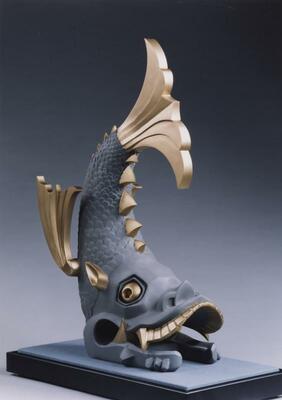
4) Research on the former site of Sokenji Temple and the Dodobashiguchimichi road
The Dodobashiguchimichi road connecting the castle town and the castle is the only road that appears in documents. Research confirmed that the route of the Dodobashiguchimichi road remained the same, while stone steps had been repaired.Sokenji Temple was built in Azuchi Castle at Nobunaga’s command. Until its major buildings were burnt down in 1854 and the temple was moved to its present location, it had been in charge of praying for the repose of Nobunaga’s soul on the Dodobashiguchimichi road. Research found many sites of buildings, including the main building. Among these buildings, ones constructed when the temple was established were only the main building, the worship hall, the tutelary shrine, the Niomon Gate, the three-story pagoda, the front gate, and the back gate. Additionally, the sites of a study and living quarters built by Toyotomi Hideyori, and sites of a number of buildings constructed in and after the mid-Edo Period were also discovered.In the former site of Sokenji Temple, only the three-story pagoda and the Niomon Gate still stand today. These two buildings and the back gate, which was moved to Chokoji Temple (Minamisuda-cho, Higashiomi City, Shiga Prefecture) and reconstructed as its front gate in the early Meiji era, are the existing buildings that witnessed the times of Nobunaga in Azuchi Castle.
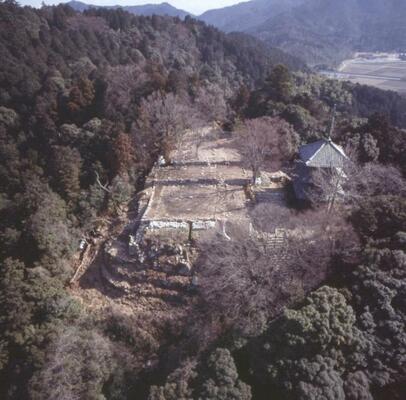
5) Research on the Karametemichi road
The Karametemichi road runs from the eastern foot of Mount Azuchi up to the castle. Research showed that, while the lower half of the road was a slope without steps, the upper half consisted of twisting stone stairways. The skirts of the mountain abutted an inner lake of Lake Biwa, which once spread to there, and ditch-like remains, which are deemed to have been created by digging shallows to let boats through, were discovered. Additionally, wooden strips deemed to have been used as freight tags were also found in this area. Taking into consideration these facts together with the structure of the Karametemichi road, the road is thought to have been a route for carrying goods into the castle.
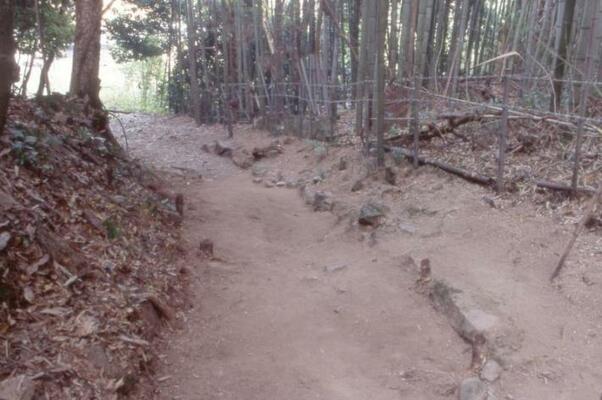
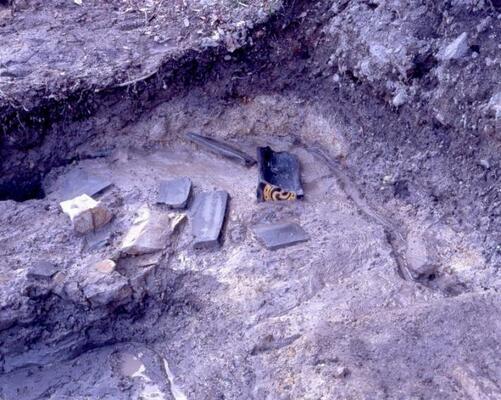
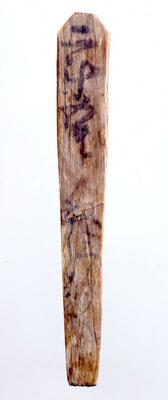
6) Research on the southern skirts of Mount Azuchi
From the supposed site of the Otemon Gate to the Dodobashiguchi entrance, parts of a stone-paved road were discovered at the feet of stone walls. Although it was thought that this row of stone walls had been outer fortifications of the castle, and this road had been outside the castle site, the discovery of two entrances between the main entrance and the Dodobashiguchi entrance suggests more clearly that this road could have been within the castle site.
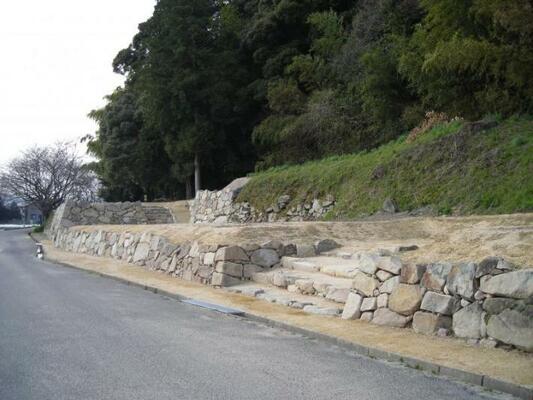
Meanwhile, such stone walls and passage are not found in the area around the Hasuike Pond, and tiers of baileys are connected by entrances to each other, as well as to the supposed site of the Eto family’s residence. These facts confirm that the area around the Hasuike Pond was within the castle site. The outer fortifications of the castle are deemed to have been located further south. By the way, the existing Hasuike Pond was constructed as part of the post-war maintenance project.
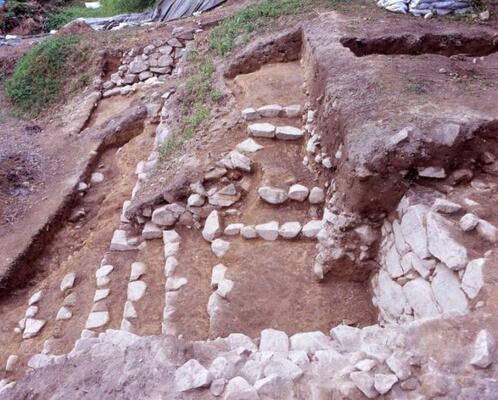
No remains of buildings have been found in bailey areas at the skirts of Mount Azuchi, and no traces of daily life were discovered from remains excavated from these areas. In consideration of their position at the southern skirts of outer fortifications, these baileys are thought to have served as the castle’s defensive facilities.
7) Research on the site of inner moats
In the area between Mount Azuchi and the Prefectural Road Otsu Notogawa Nagahama Line, a row of stone walls running east and west was discovered about 100 m north from the prefectural road. It was found that the bases of these stone walls had been reinforced with logs, which had prevented the stone walls from falling down due to differential subsidence. Since logs were often used in this way when stone walls were built on the soft ground, it has become clear that these stone walls were those of moats.
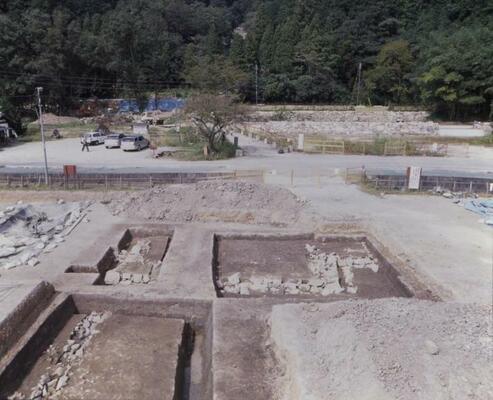
Additionally, the trace of a structure protruding south from the extension of the row of the stone walls was discovered. The trace is located due south from the supposed site of the Otemon Gate, so the structure is presumed to have been a facility related to the gate: more specifically, an abutment for a bridge connecting the road running south of the inner moats and the gate, or a wharf.
3. Structure of Azuchi Castle
It can be said that Azuchi Castle focused on the demonstration of Nobunaga’s political power through its magnificence, unlike other traditional castles, which were built for the purpose of defense. The splendor and brilliance of its donjon, in particular, is a symbol of his strong political appeal. Moreover, the structure of the area between the Otemon Gate and the Otemichi road is beyond our understanding based on conventional theories about castles in Japan. The structure is presumed to have been adopted to receive visits from the Emperor. In this sense as well, Azuchi Castle is fundamentally different from castles built before it.The establishment of political control in such a symbolic way is surely a function of a castle in the early modern era of Japan (which usually refers to the period between national unification by Toyotomi Hideyoshi in 1590 and the end of the Tokugawa Shogunate in 1867). A high-rise donjon founded on tall stone walls, the use of roof tiles and shachihoko-fish-shaped ornaments, and the introduction of magnificent architecture, including turret gates and palaces, are features passed on to castles in the early modern era. In that sense, Azuchi Castle can be viewed as a starting point of early-modern castles. The castle, however, also had characteristics particular to castles built around the end of the Warring States period, when national unification had not yet been achieved, including defensive facilities found in the Hasuike area, and baileys along the ridge line. Azuchi Castle can be thus seen as a castle with features of both early-modern and medieval castles, reflecting the transition between medieval and early-modern eras.
4. Facility maintenance of the Azuchi Castle Site as a special historic site
In 1926, Azuchi Castle was designated as a historic site to be preserved as a cultural property by the national government. In 1952, the castle was designated as a special historic site under the Cultural Properties Protection Law. The site of the castle had, however, long been so abandoned except for such places as the Nobunaga Shrine that bushes had grew and the stone walls had been left destroyed.In 1940 and 1941, research on the donjon and the supposed site of the Honmaru bailey was conducted for the purpose of facility maintenance, and partial maintenance work was done regarding remains discovered during the research. Moreover, between 1960 and 1975, full-scale repair work, including reconstruction of stone walls, was conducted in the main bailey area.In 1989, a 20-year project to conduct excavation at the Azuchi Castle site and facility maintenance based on the findings of the excavation started with the aim of promoting preservation and wider use of the Azuchi Castle site as a special historic site. Facility maintenance focused on careful preservation of remains, instead of drastically changing the current conditions of the site, and the scope of restoration work was restricted to necessary work. In the site designated as a special historic site, there are two buildings that were constructed at the times of Nobunaga: the Niomon Gate and the three-story pagoda in the former site of Sokenji Temple. Restoration of other buildings is not planned at the present.
1) Maintenance of roads
Roads and stone steps were restored as they were when constructed by using excavated stepping stones at the same spot, and, when no existing stones were available, by using stones excavated at nearby spots or of similar types. Stone forts and ditches on both sides of roads were restored in the same way.
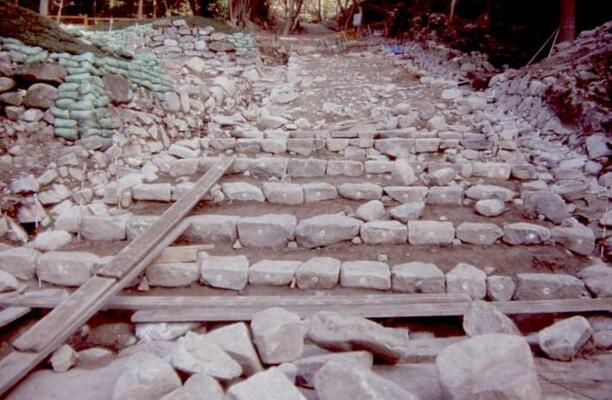
2) Maintenance of baileys
The ground of baileys in flat parts was paved with permeable soil to preserve excavated remains. Lost parts of excavated stone-paved ditches and stone steps were restored with the same types of stones. Excavated foundation stones are basically exhibited, and small foundation stones are displayed with artificial foundation stones placed directly on heaped soil covering the small genuine stones, and with signs indicating the positions of the genuine stones.
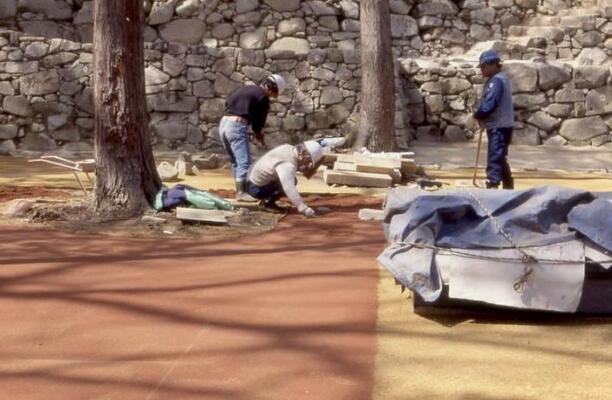
3) Maintenance of stone walls
The stone walls of Azuchi Castle were built with the type of stone called Koto rhyolite, produced in the area to the east of Lake Biwa, including Mount Azuchi and Mount Kinugasa, except for granite Buddhas and the like. Stone walls were built skillfully with hardly processed natural stones. Maintenance of these stone walls was conducted based on research focusing on the careful preservation of the stone walls built at the same time as the castle, and restoration work was done for parts necessary to be restored for safety purposes by adopting the construction methods used when the castle was built.
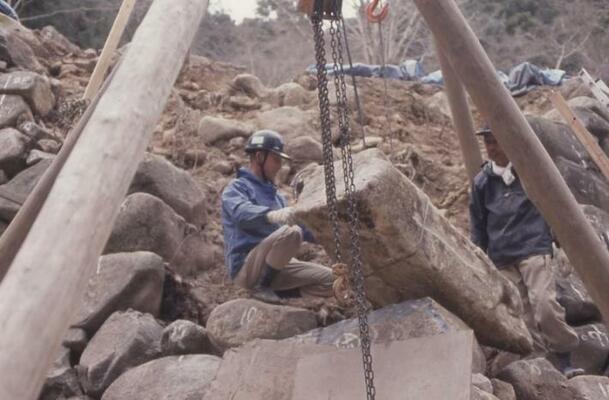
History and structure of Azuchi Castle town
Azuchi Castle town is presumed to have been located around present-day Shimotoyoura, Kamitoyoura, Jorakuji, Jionji, and Konaka in Ohmihachiman-cityo. This area is thought to have contained the Toyoura estate of Yakushiji Temple, and it can be thought that villages in the temple estate were incorporated to establish the castle town. In other words, Azuchi Castle town was not newly created by Nobunaga, but shaped by using pre-existing hamlets. One structural feature of Azuchi Castle town is that it has three areas arranged along the lines in different angles. Blocks in the area around Jorakuji, Jionji, and Konaka are arranged along the same line as Gamou-gun blocks created in the ancient times. In the area around Shimotoyoura and Kamitoyoura, east to the above area, blocks are arranged along the line about 20 degrees east from the above area, and blocks in the triangle area called Shinmachi, further east to Shimotoyoura, are arranged another 20 degrees east. From this fact, it was thought that, while the area around Jorakuji had been arranged by using the old arrangement of blocks, the block arrangement of the areas further east of Shimotoyoura had been newly created. However, the axes of the two areas further east of Shimotoyoura correspond to the approach road to Ikitsuhikone-jinja Shrine and the approach road to Shingu-jinja Shrine respectively. Given that both shrines existed before the castle town was created, it may be said that blocks in these areas were arranged by using pre-existing arrangement of blocks, instead of being newly created.Nobunaga issued 13 rules to Azuchi Castle town to implement urban policy, including free markets and open guilds (rakuichi rakuza). He aimed to create a castle town as a place where safety and liberty are guaranteed, with the aim of encouraging people to live densely in the urban area. Moreover, he did not divide the town into merchants’ residential area and a commercial area to make the entire castle town into a free market. Such unified structure is found in early-modern castle towns, and Azuchi Castle town is recognized as the starting point of early-modern style of castle towns. However, the findings of recent research require us to reconsider this recognition.It was thought that Azuchi Castle town did not have sogamae(large-scale earth mounds and moats) for protecting residents and the town in the time of war, like Kiyosu and Gifu. However, research on ancient documents found in Azuchi-cho (though documents from the Genroku era in the Edo Period) discovered a picture with a writing of “sogamae dote,sogamae. But opinions are divided on whether this earth mounds corresponds to sogamaeof castle towns in the Warring States period, or whether it was a border for segregation of residence by status. Anyway, it is certain that Azuchi Castle town was roughly divided into two areas.Additionally, roads in Azuchi Castle town had various defensive measures, including the winding Shimokaido road, and T-junctions and hook-shaped junctions found in many places in the Uchimachi area. Azuchi Castle town abuts Jogonin and Jorakuji deemed as a hamlet surrounding a temple, and the Oegawa River further west, in the west, an inner lake in the north, moats and wetland continuing from the outer moats of Azuchi Castle in the east, and Mount Jorakuji in the south, and sogamaewas built in the environment created by skillfully using natural geographical features. These features are structures unique to castle towns in the Warring States period.Along with Azuchi Castle, the originality of Azuchi Castle town has been conventionally emphasized as the starting point of the early modern era. However, more detailed examination reveals restrictions of the time of the late medieval era on Azuchi Castle town. A combination of old and new features is a major characteristic of Azuchi Castle and the town around it.
What to see at the site of Azuchi castle town
Shimotoyoura / Kamitoyoura area
1) Ikitsuhikone-jinja Shrine
This shrine is dedicated to the deity Ikitsuhikonenomikoto. An eleven-headed Kannon statue possessed by the shrine has a writing of shojin(meaning “the temple estate’s deity”), which suggests that this deity was the guardian of the Toyoura-sho estate. Fujiwara no Toyonari, Minister of the Right, confined himself in this shrine to pray for the Emperor Shomu’s recovery from disease. A picture map drawn in the Edo period calls this shrine “Shimomura Hiraimura miya.” At the present, there are the main building, the worship hall, the Nakamon Gate, the offering hall, and the Ebisu-sha Shrine as a precinct shrine. Among these buildings, the main building, with a plate saying “the third year of Kan’ei” (1626), is designated as a cultural property of Omihachiman City.
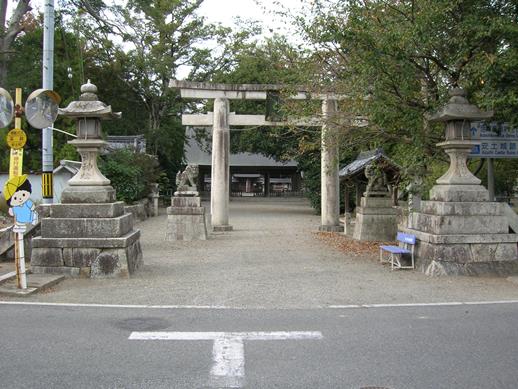
2) Shingu-jinja Shrine
This shrine is dedicated to a deity called Hayatamaonomikoto. Tradition says that it was established in 1131, but there is no evidence. The Great Wisdom Sutra (Daihannyakyo) possessed by Shozenji Temple, Azuchi-cho, Omihachiman City, has a writing saying that a sacred book was offered to Toyoura Shingu-taisha Shrine in 1403, and this record suggests that this shrine existed before the castle town was created. A picture map of the Edo period calls it “Higashimura miya.” At the present, Omiyasha as the main building, precinct shrines, including Seisha, Wakamiyasha, Hayatamasha, Daijingu, and Tsushimasha, and the worship hall. The colored image on silk of sixteen deities protecting the Wisdom Sutra, the main building, and the worship hall are designated as cultural properties by Omihachiman City.
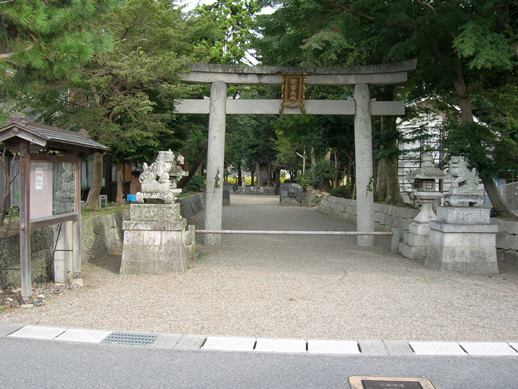
3) Sogamae-dote
An Edo-period picture map depicts sogamae-dote (large-scale earth mounds and moats). It was located around the south of the present-day Azuchi Community Center. Moreover, another document of the Edo period says that earth banks built in the times of Nobunaga were broken to obtain a site for a temple. This description suggests that there were banks in this area, whether or not they were related to Azuchi Castle. Today, there is no trace of the banks.
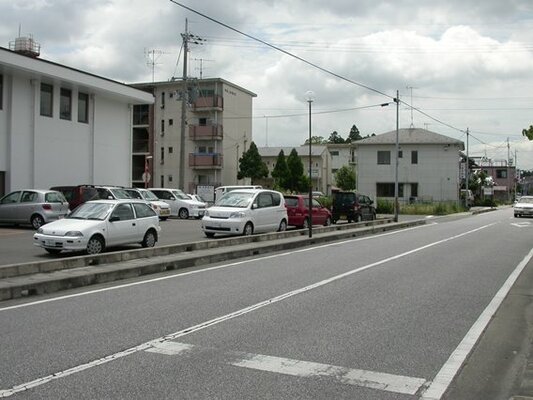
the Supposed site of Sogamae-dote
4) The former site of a seminario
Nobunaga gave a Christian missionary a residence in Azuchi Castle town. A document says that the house had three stories, and was thatched with roof tiles. The third floor was a seminario, a Christian theological school. However, the location of the seminariobuilding is not yet identified. A place at the eastern end of the Azuchi Castle town and a site in the Shinmachi area are candidates of the site of the seminariobuilding.One of the candidates is the place in the south of Shingu-jinja Shrine, and the word “shunomizaDaiusuShincho kokisays that the house of the missionary was built by burying moats in the south of Azuchi Castle, and this is the case for both candidate places. Further research is expected.
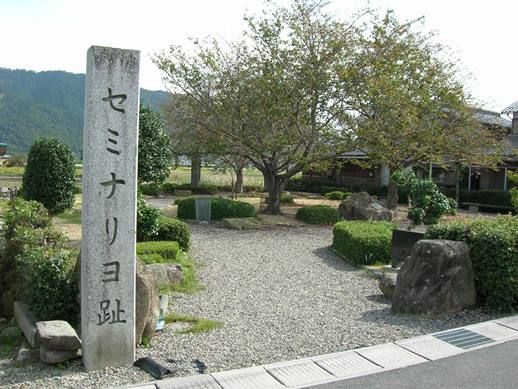
Jorakuji / Jionji area
5) Sasaki-jinja Shrine
This shrine is dedicated to four deities: Sukunahikonanomikoto, Ohikonomikoto, the Emperor Nintoku, the Emperor Uda / the Prince Atsuzane. This shrine is presumed to correspond to the shrine with the same name mentioned in the Engishiki list of shrines. This shrine is also known as the guardian of the Omigenji Sasaki family, who ruled Omi in the medieval era. Shincho kokisays that merchants offered Noh performance at Sasaki Shrine to reward wild geese and cranes given by Nobunaga in 1581. At the present, there are the main building, the Nakamon Gate, fretwork walls, a temporary shrine, the worship hall, a tower gate, the east corridor, and the west corridor, all of which are designated as cultural properties by Shiga Prefecture.
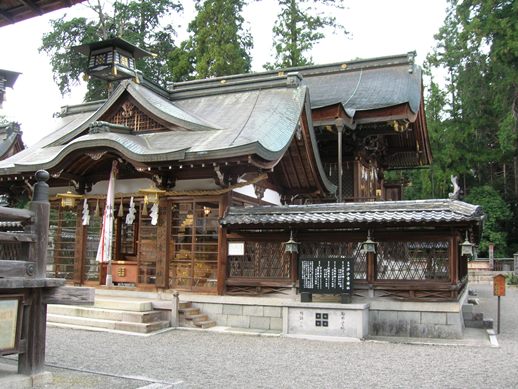
6) Jogoin Temple
Jogoin Temple is a Jodoshu-sect temple originated from a hut (later called Amidadera Temple) built by the monk Jogonbo Ryugyo in Konzeyama, Kurita-gun, Omi-no-kuni (present-day Ritto City, Shiga Prefecture). When meeting the Amidadera Temple’s eighth priest Oyomyokan on the way to hawking, Nobunaga was deeply impressed by his personality, and invited him to live in Azuchi Castle town and built a temple. This temple is famous as the place of the Azuchi controversy between the Jodoshu sect and the Hokkeshu sect in 1579. There are the main building, a tower gate, Fudodo Shrine, Shakado Shrine, a tea house, a belfry, the back gate, a study, living quarters, a guardian shrine, Shunyoin, Seiyouin, and other buildings at the present. The main building and the tower gate are designated as important cultural properties, and many daily life goods found in this temple are designated as cultural properties.

7) Jorakuji Port
This port is well-known as a port from which temple estate tax were carried out on board. The present Jonohama Park contains traces of ships having entered and departed.
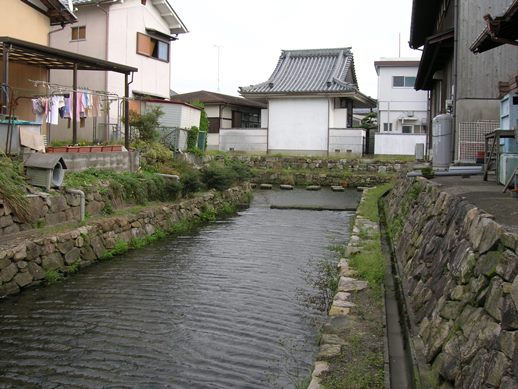
8) The site of Kimura Castle
This is the supposed site of the castle of the powerful Kimura clan. The Kimura clan served the Rokkaku clan, and became a follower of Nobunaga after Nobunaga invaded Omi. Kimura Jirozaemon of the Kimura clan became a city commissioner after the completion of Azuchi castle town. The Kimura clan’s residence is presumed to have been located in present-day Aza Kimura, Oaza Jorakuji, Ohmihachiman-City Azuchi-cho, and to have used canals connected to the Jorakuji port as moats. The supposed site is just fields now, but the former moats remain as canals.
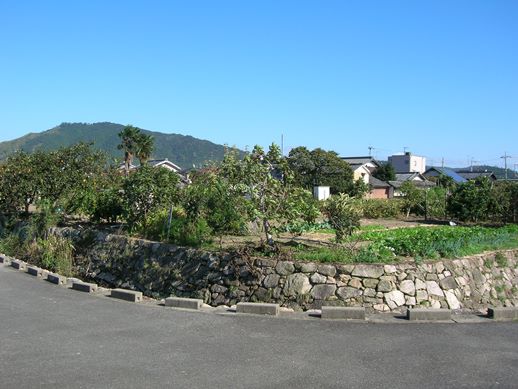
9) Umenokawa
Umenokawa is the name of a place in Aza Odo, Oaza Jorakuji. Tradition says that Takei Sekian, a retainer of Nobunaga, made a cup of tea with spring water available here, and offered it to Nobunaga. Jorakuji has two other springs: Kitagawa (9) and Otondo (10).
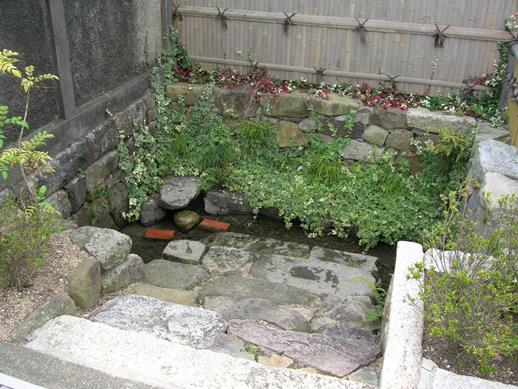
11) Jinai
Jinai is the name of a place in present-day Aza horikiri, Oaza Jorakuji. “Midoyashiki,” the name of the place in the north of Jinai is also known today. Since a Buddhist statue created in the mid-Heian period was discovered in a nearby moat called “hyakkenbori,” this place is presumed to have been the site of Kounji Temple, the guardian temple of Rokkaku Sadayori, the military governor of Omi.Additionally, Honganji Hachiman Betsuin Temple, located in Omihachiman City today, is deemed to have been located in the Azuchi Castle site before moving to its present location.
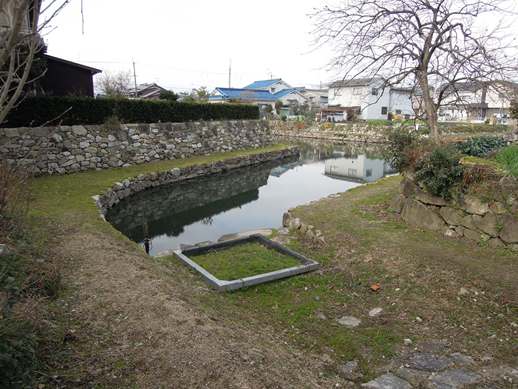
Konaka area
12) House of the Iba family
This is a house built by order of Iba Sadatake (1847-1926), the second general director of the Sumitomo merchant family. Iba Sadatake was born in Nishishuku Village, Gamo-gun (present-day Omihachiman City), and joined the Sumitomo family after working in the Ministry of Law. He made a great contribution to the solution of the smoke pollution problem at the Besshi copper mine, and, after retiring at age 57, lived his last years at his villa in Ishiyama (Otsu City, Shiga Prefecture). In this house, completed in 1913, Iba Shinkichi, the fourth son of Iba Sadatake and later mayor of Azuchi village, lived. This three-story wooden house was designed by William Merrell Vories, an American architect. It is Vories’ early ambitious work which combines Western-style appearance with characteristics of Japanese architecture. It is designated as a cultural property by Omihachiman City.
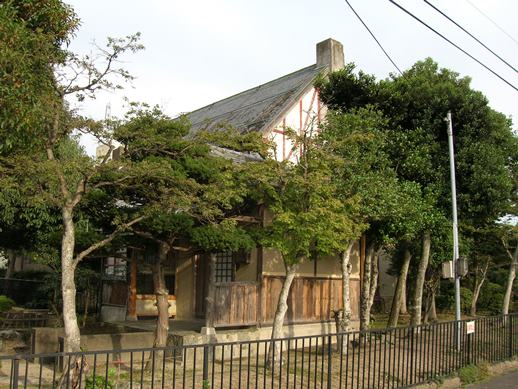
13) Wakimiyahachiman-jinja Shrine
It is unknown when this shrine was built. The Great Wisdom Sutra (Daihannyakyo) possessed by Juge-jinja Shrine (Shiga—cho, Ohtsu-city, Shiga Prefecture) says that Rokkaku Ujiyori, the military governor of Omi, offered a sacred book to Goshu Sasaki Shinhachimangu Shrine in 1379. Wakimiyahachiman-jinja Shrine is presumed to correspond to Sasaki Shinhachimangu Shrine.
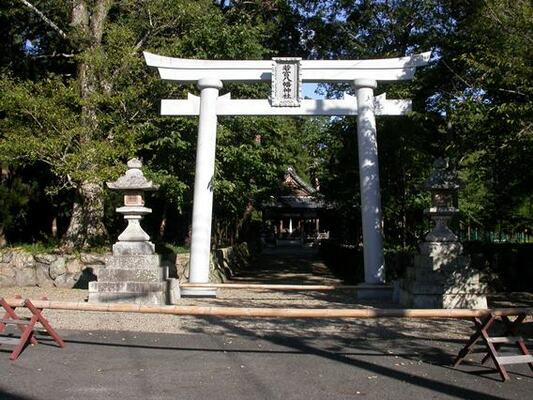
Major roads running through the castle town
Shimokaido road
The Shimokaido road runs through Azuchi castle town. Although it is unknown where this road connected to the Tozando road, the main road at that time, this road was built by order of Nobunaga to attract passengers on the Tozando road to the castle town when the town was created. Since Korean envoys used this road to go to Edo in the Edo period, this road is also called Koreans’ road.
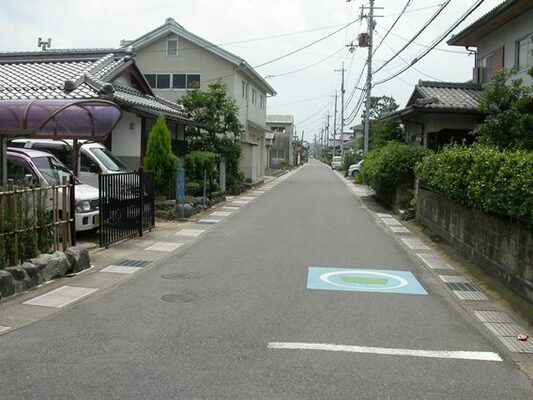
Kagekiyomichi road
The Kagekiyomichi road goes from the Tozando road through the southern skirts of Mount Kinugasa and Ishidera Town, over the Toriuchi Pass in Mount Kinugasa, to Kuwanomidera, hamlets of Konaka, and the front of the gate of Jogonin Temple. It is said that this road is called Kagekiyomichi because Taira no Kagekiyo, a warrior in the late Heian period, used this road to go from Owari to Kyoto. Another version of explanation says that the name originated from the word “kage no michi” (meaning “a road of shades”) to be taken to avoid major roads.
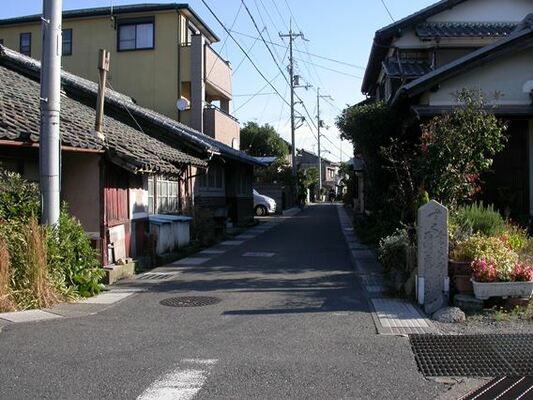
[Access]
25 minutes on foot from JR Biwako Line Azuchi Station
About 10 minutes from JR Azuchi Station by rental bicycle available at the station
About 5 minutes by taxi from JR Azuchi Station
[Hours and fees]
- Hours for entering the Mount Azuchi area: 9 a.m. to 5 p.m. (The hours are subject to change depending on the season.)
- Fees for entering the Mount Azuchi area: 700 yen
- お問い合わせ
- 文化スポーツ部 文化財保護課 安土城・城郭調査係
- 電話番号:077-528-4678
- FAX番号:077-528-4956
- メールアドレス:[email protected]















